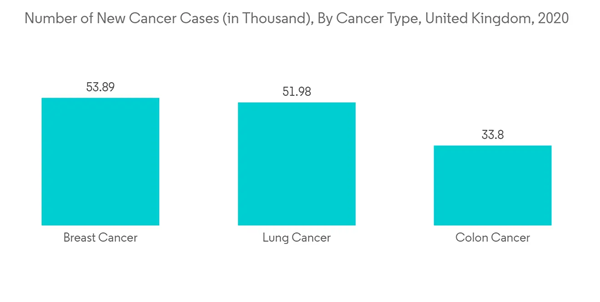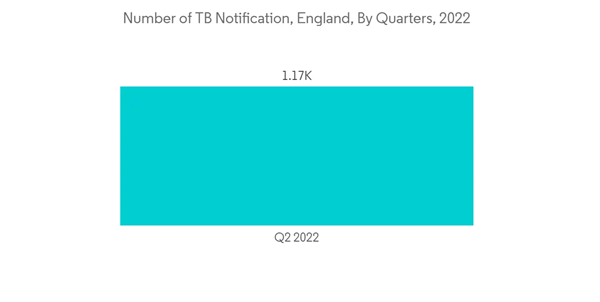Key Highlights
- The United Kingdom's drug delivery devices market is anticipated to register a CAGR of 22.81% during the forecast period.
- With the emergence of the COVID-19 pandemic, most pharmaceutical companies and governments have strived to offer COVID-19 patients appropriate medical therapy and drug delivery devices pandemic. For example, large-scale vaccination programs were being implemented worldwide to immunize people against the SARS-CoV-2 virus. However, many companies are still working on more efficient ways of delivering COVID-19 therapeutics to patients and are investing heavily in it, which is expected to impact the drug delivery market significantly.
- For instance, in January 2022, UK physicians began clinical development of a nasal spray designed to prevent infection with the coronavirus and treat mild to moderate cases of COVID-19. The spray delivers nitric oxide into the nasal passages to destroy the virus at a site it used to enter the body and begin replicating. As a result, COVID-19 has contributed to the expansion of the drug delivery devices market in the United Kingdom. Additionally, the market is anticipated to maintain this trend over the projected period as more research and development for drug-delivery devices is expected in the upcoming years.
- The rising prevalence of chronic diseases, technological advancements, and growth in biologics are some of the key factors driving the growth of the UK's drug delivery devices market. Many disorders, including cardiovascular disease and diabetes, can benefit from targeted drug administration. The most important application of targeted medication delivery is the treatment of malignant tumors. As a result, the increasing prevalence of cardiovascular disease, diabetes, and cancer disorders will likely drive market expansion during the forecast period.
- For instance, according to the Globocan 2020 fact sheet, 53,889 new cases of breast cancer and 56,780 new cases of prostate cancer were recorded in the United Kingdom in 2020. Thus, the rising prevalence of chronic diseases among the population is expected to boost the demand for targeted drug delivery devices, thereby boosting the market growth.
- Additionally, Type 1 and Type 2 diabetes prevalence rates are increasing primarily due to obesity, a poor diet, and inactivity. According to the British Diabetic Association, Diabetes Prevalence 2021 data show that the number of people living with diabetes in the United Kingdom has increased by more than 150,000 since 2020.
- In the United Kingdom, it is projected that more than 13.6 million people are at higher risk of developing type 2 diabetes. At this rate, the number of diabetics, including the undiagnosed, is predicted to reach 5.5 million by 2030. Thus, this will likely create demand for advanced drug delivery devices, boosting the market growth.
- However, the risk of needlestick injury may restrain market growth over the forecast period.
UK Drug Delivery Devices Market Trends
Topical Drug Delivery Devices is Estimated to Witness a Healthy Growth in Future.
- Topical drug delivery devices are estimated to witness healthy growth in the future due to several benefits associated with this type of route of administration, such as ease of use, painless and noninvasive delivery, convenience, and superior spreadability. In addition, the rising prevalence of skin diseases and improved patient compliance are expected to support market growth.
- For instance, according to the World Health Organization (WHO) statistics updated in May 2021, every year, around two million people are diagnosed with non-melanoma skin cancers and 132,000 with melanoma, and the frequency of the disease continues to rise. The main cause of increased skin cancer rates is ozone depletion, which means more harmful UV radiation reaches the earth's surface. WHO estimates that a 10% decline in ozone levels leads to an additional 300,000 instances of skin cancer. Thus, the growing prevalence of skin diseases is expected to propel the segment's growth over the forecast period.
- In addition, with the advent of novel drug delivery systems, topical drug delivery systems have recently gained pace. With the help of modern mathematical models, sophisticated instrumentation, and computational power, the formulation process has been revolutionized by the advancement of topical drug delivery systems.
- For instance, in September 2021, Almirall launched Klisyri (tirbanibulin), a brand-new, first-in-class topical microtubule inhibitor in Europe for managing actinic keratosis. The United Kingdom and Germany are the first European countries where Klisyri can be available on prescription.
- Additionally, in September 2021, Pfizer received marketing approval from the UK drug regulators for Cibinqo (abrocitinib), an oral JAK inhibitor cream for treating mild to moderate atopic dermatitis in patients aged 12 years. Thus, all factors mentioned above are expected to boost segment growth.
Infectious diseases is Expected to Hold a Significant Market Share Over the Forecast Period
- Infectious diseases are illnesses caused by organisms like bacteria, viruses, fungi, or parasites. Some common communicable (infectious) diseases in the UK include measles, mumps, rubella, meningococcal, chicken pox, whooping cough, tuberculosis, scarlet fever, flu, and the common cold.
- The drug delivery devices segment is driven by the increasing prevalence of infectious diseases and product launches by the market players.
- As per the report published by the UK Health Security Agency (UKHSA) in December 2021, an estimated 97,740 people were living with HIV in England in 2020, and approximately 4,660 were unaware of their infection. The high burden of HIV in the country is expected to increase the demand for its therapeutics consumption, thereby driving the drug delivery devices market.
- Moreover, product launches in the market are further expected to impact the market growth positively. For instance, in June 2021, Glenmark Pharmaceuticals Ltd launched a bioequivalent version of Tiotropium Bromide dry powder inhaler (DPI) under the brand name Tiogiva in the country to treat chronic obstructive pulmonary disease (COPD).
- Furthermore, increasing research and development activities to produce sustainable drug delivery methods for COVID-19 vaccines will likely drive market growth.
- For instance, in December 2021, researchers at the University of Cambridge started a clinical trial on a needle-free, air-powered vaccination. This vaccine is intended to help fight COVID-19 variations in the future. The next-generation coronavirus vaccine, developed at the University of Cambridge and spin-out business DIOSynVax, is delivered through a blast of air that penetrates the skin. Such research activities boosting innovation are also likely to contribute to the market growth over the forecast period.
- Thus, all aforementioned factors, such as the increasing burden of infectious diseases and strategic initiatives by market players, are expected to boost the market over the forecast period.
UK Drug Delivery Devices Market Competitor Analysis
The UK drug delivery devices market is moderately competitive and consists of several major players. Some companies currently dominating the market are Pfizer Inc., Novartis AG, F. Hoffmann-La Roche Ltd, Johnson & Johnson Services, Inc, Becton, Dickinson and Company, and 3M, among others.Additional benefits of purchasing the report:
- The market estimate (ME) sheet in Excel format
- 3 months of analyst support
This product will be delivered within 2 business days.
Table of Contents
Companies Mentioned (Partial List)
A selection of companies mentioned in this report includes, but is not limited to:
- Pfizer Inc.
- Novartis AG
- F. Hoffmann-La Roche Ltd
- Johnson & Johnson Services, Inc
- 3M Company
- Becton, Dickinson and Company
- Baxter International Inc.
- Teva Pharmaceutical Industries Ltd
- Enesi Pharma
- Oval Medical Technologies Ltd.










